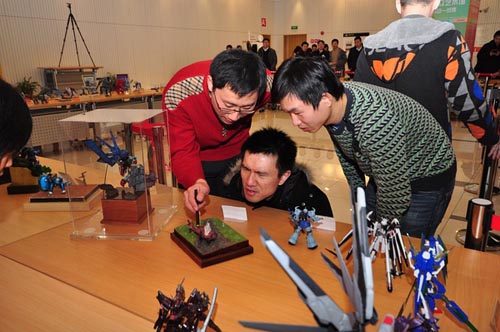Making authentic, scale models of military vessels, aircraft and other vehicles is a passion for a handful of military history buffs and craftsmen. An exhibition is underway.

Once upon a time, many boys were crazy about making models of military vessels, aircraft, tanks and other war machines. They immersed themselves in military history and battlefield legends. Working with basic kits of plastic, metal and wooden parts, they meticulously assembled scale models and painted them.
Today homework comes first so there's far less time for hobbies. But there are still dedicated amateur model-makers and professionals who turn out remote-controlled models for a living.
Models are exact, down to the last movable screw, piston, gas tank cap and antenna. They can be fueled and launched. The paint matches that on the real vessels. Some vintage works are painted to look naturally rusted, and a reconstructed battle scene even contains specks of dust and rubble. Replicated vegetation is authentic.
The kits for models are far more sophisticated nowadays; some have thousands of parts and require more than 100 tools to assemble. There's a vast online market selling kits for ancient, vintage and modern vessels, aircraft and battlefield equipment. But Shanghai today has fewer than 10 bricks-and-mortar stores that model-makers can browse.
An exhibition underway at the Shanghai Public Art Center on Guyi Road features 12 elaborate, award-winning works by professionals on the first floor and more than 100 works by dedicated amateurs on the second.
The first-floor exhibition runs through tomorrow, while the second floor is open through January 25.
Obsession
Shi Wei, a 26-year-old amateur, and Sun Hefeng, a 27-year-old professional, became obsessed with making models, mostly military vessels, when they were in primary school. Today they are every bit as enthusiastic and they are still glued to their replicas.
Six years ago they set up Model Z club in Shanghai for model zealots like themselves. Today it has around 200 members. Anyone, at any level of craftsmanship, can join; membership is free.
"Models are like artworks for us," says Shi, who sells air-conditioners and makes extremely sophisticated models in his spare time. He makes time by giving up some dinners with friends and KTV.
Sun is a member of the city's marine model team that takes part in national and international competitions in which works are judged by authenticity, craftsmanship, speed and mobility. "Making models is like creating pieces of art," he says.
There are competitions for marine models, involving both speed and appearance in the world, and the Chinese Marine Model Association in China recruits and trains "sports" persons to take part in global competitions, notably by the Vienna-based Naviga organization.
On the first floor of the Shangai Public Art Center, visitors can see Sun's award-winning model of the Nagato, commissioned in 1920, the major battleship of the imperial Japanese navy in the Battle of Leyte Gulf (in the Philippines) in October 1944. The scale is 1:350 and the model is around 70 centimeters in length.
It contains 20,000 parts, the smallest around "one-fifth of the length of an ant," Sun says. He worked full time every day for four months on the model.
Seven years ago, Shi and Sun launched the annual Shanghai New Year Model Contest, open to everyone. The 2012 event drew 127 submissions; the youngest model-maker is only seven years old, the oldest is 73. It includes military and civilian models, as well as figures from science fiction, comics and animation.





Why not rent a boyfriend, or girlfriend to please parents during the Spring Festival?